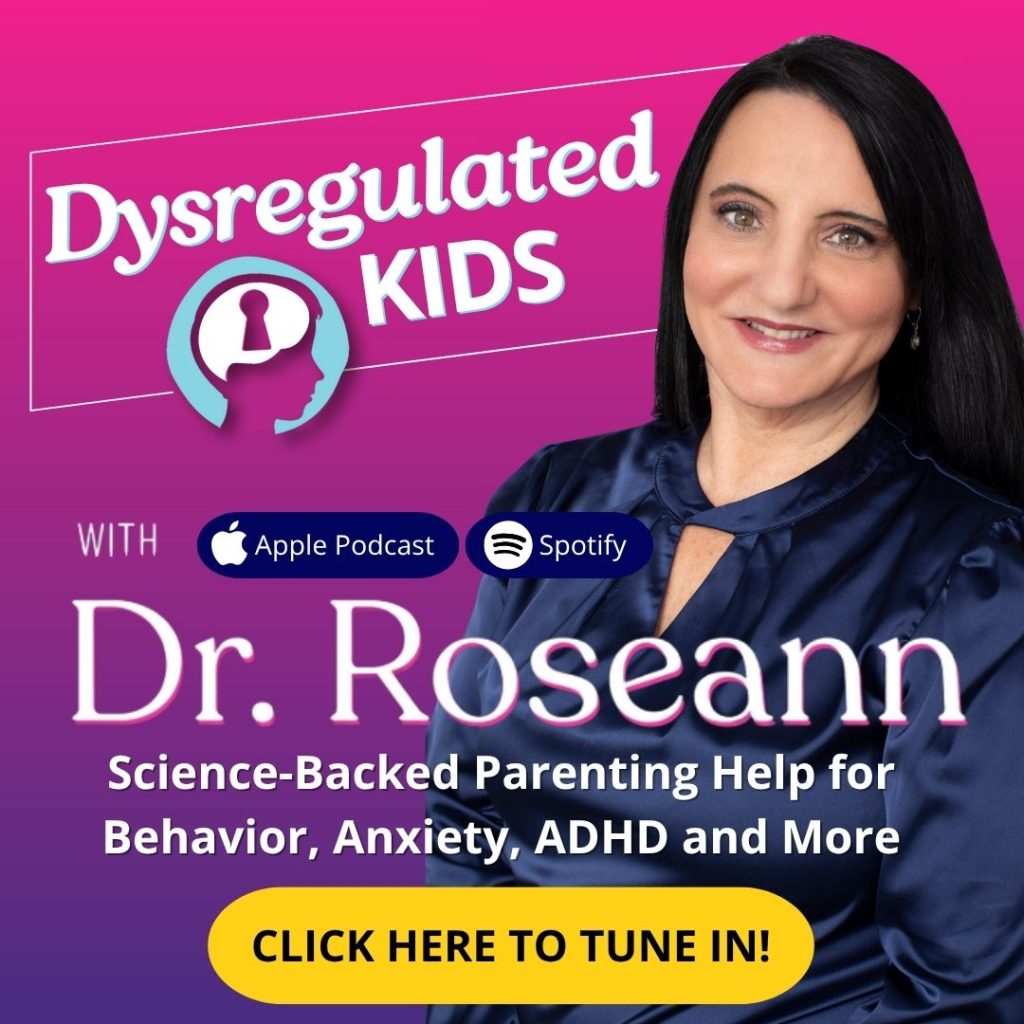Estimated reading time: 10 minutes
This guide shows you exactly how to calm eight child behavior problems with a simple brain-first plan you can use today.
If your child’s behavior feels out of control, you’re not alone. Parenting a dysregulated kid is exhausting—and it isn’t your fault.
When we calm the nervous system first, skills stick. This article gives you clear, parent-tested steps for eight common challenges—without shame or blame.
You’ll learn quick de-escalation tools, scripts that invite cooperation, and how to build self-regulation skills so behavior improves for good.
Why Behavior Problems Happen
Most “problematic” behavior is communication from an overwhelmed brain. Stress, poor sleep, sensory overload, learning gaps, or conditions like ADHD, anxiety, OCD, and ASD. Or PANS/PANDAS can keep the nervous system on high alert (Ogundele, 2018).
When the brain is in stress mode, logic shuts off. Calm first—then skills work.
Regulate → Connect → Correct.™ Calm the brain, connect with the child, then teach the skill.
What to watch: frequency, intensity, duration, safety, and whether issues show up across settings. If challenges persist 6+ weeks or harm is involved, get help.
Why Your Child Lies—And How to Encourage Honesty
Problem 1: Lying
Kids lie to avoid shame or hard feelings. It’s an avoidance strategy, not a character flaw.
Try this (brain-first):
- Regulate: Soften your tone. Breathe slower. Keep your face kind.
- Connect: “Were you worried I’d be upset?” Safety invites truth.
- Correct: Praise brave honesty even if a consequence follows. Offer a redo: “Tell me again with the truth.”
- Teach: Truth-first script: “Telling me the truth makes problems smaller.”
Parent example:
Ramon swapped “Did you lie?” for “Help me understand what happened.” Honesty increased; battles decreased.
Tip for parents:
Build a family behavior plan that rewards truth-telling.
How to Calm Temper Tantrums Fast (Without Giving In)
Problem 2: Temper Tantrums
Tantrums appear when feelings are too big for the child’s skills. Logic is offline.
Do now:
- Regulate: Say less. Lower your voice. Guide four slow breaths.
- Connect: “I’m right here. We can do hard things.”
- Correct: After the storm, teach a 90-second reset (cold water, wall pushes, 4–6 breathing).
Parent example:
Reina added a daily post-school reset. Meltdowns dropped by half in two weeks. Research shows parent coaching cuts tantrums in half (Mingebach et al., 2018).

What to Do When Your Child Talks Back or Acts Disrespectfully
Problem 3: Disrespect/Defiance
Backtalk signals low frustration tolerance or anxiety, not moral failure.
Do now:
- Regulate: “We’ll talk when our voices are calm.”
- Connect: Offer a tiny choice: “Brush teeth or put on PJs first?”
- Correct: One clear limit + brief follow-through; praise cooperation fast.
Parent example:
Marnie used a one-line limit + choice. Power struggles dropped, morning routine sped up.
“Kids do well if they can.” — Ross W. Greene (2014).
When you see defiance, think of a skill gap, not a bad attitude.
How to Stop Constant Whining
Problem 4: Whining
Whining persists because it works—it gets attention or a delay.
Do now:
- Regulate: Keep a neutral face; breathe.
- Connect: “I answer calm voices.”
- Correct: Actively ignore whining; respond the moment voice resets; teach replacement phrases.
- Teach: Two-step request: Ask calmly → wait for timer → answer.
Pro tip:
The CDC recommends ignoring minor misbehavior while giving quick positive attention once the child resets. This reduces challenging behavior (see CDC parenting resources).
Why Your Child Is So Aggressive—And What Helps Right Now
Problem 5: Aggression (hitting, biting, throwing)
This is body overload. Safety first.
Do now:
- Regulate: Move objects/people. “I won’t let you hit.” Offer cool water or deep pressure.
- Connect: Name the feeling: “Your body is HOT mad.”
- Correct: After, guide repair: check on the person, clean up, and practice a coping line (“I need space!”).
Aggression peaks around ages 2–4 for many children, then typically declines; persistent patterns need early support (Teymoori et al., 2018).
How to Help an Impulsive Child Think Before Acting
Problem 6: Impulsivity
Common in ADHD and sensory challenges—kids act before the brain can pause.
Do now:
- Regulate: External pause cue (squeeze tool, “freeze” signal).
- Connect: Celebrate every tiny success in thinking before doing.
- Correct: Practice “Stop-Think-Do,” red-light/green-light, timers; use self-regulation skills games daily.
“Skill building—not reprimand—changes behavior.” — Alan E. Kazdin, Yale Parenting Center
If impulsivity disrupts school or friendships, request an ADHD evaluation and a classroom plan.
What to Do if Your Child Seems Lazy or Unmotivated
Problem 7: Lack of Motivation
Looks like laziness; often it’s avoidance or low dopamine drive.
Do now:
- Regulate: Shrink the task; start with a “sure win.”
- Connect: Tie interests to work (music timer, favorite topic).
- Correct: Chunk tasks + instant feedback; use visual progress bars.
Parent example:
Aisha used her 9-year-old’s love of cars. He earned “pit-stop minutes” for each homework chunk. Momentum returned.
How to Respond to Bullying— Regardless of Victim or Aggressor
Problem 8: Bullying
Bullying can be a form of power over pain. We protect targets and teach skills to aggressors.
If your child is targeted:
- Regulate: Validate; stabilize safety with adults and the school.
- Connect: Rehearse assertive scripts: “Stop. I’m leaving now.”
- Correct: Document incidents; loop in the school per policy.
If your child is bullying:
- Regulate: Immediate, calm limit—no shaming.
- Connect: Explore the “why” (anxiety, control, skill gaps).
- Correct: Teach empathy and repair; set consistent boundaries at home and school.
“Parent-focused coaching improves observed interactions and reduces externalizing behavior” (Mingebach et al., 2018).
Decode & Do
Behavior | What the Brain Is Saying | What to Do (Regulate + Connect Now → Correct Later) |
Lying | “I’m scared of trouble.” | Regulate: soften voice Connect: empathy Correct: truth-first script + redo |
Tantrum | “I’m overloaded.” | Regulate: breathe together Connect: “I’m here.” Correct: 90-sec reset routine |
Disrespect | “I feel powerless.” | Regulate: one calm limit Connect: offer small choices Correct: practice transitions + praise |
Whining | “This gets attention.” | Regulate: actively ignore Connect: respond to calm voice Correct: replacement phrases |
Aggression | “My body is on fire.” | Regulate: block + cool Connect: name feeling Correct: repair + coping line |
Impulsivity | “Act now, think later.” | Regulate: pause cue Connect: celebrate attempts Correct: “Stop-Think-Do” games |
Low Motivation | “This feels pointless.” | Regulate: tiny wins Connect: tie tasks to interests Correct: chunking + fast feedback |
Bullying | “I need control.” | Regulate: firm, safe stop Connect: explore function Correct: empathy, assertiveness, limits |
Calm the Brain, Change the Behavior
Take a breath—you’re doing better than you think. Child behavior problems aren’t failure—they’re messages from a stressed brain.
Start small: one tool, one boundary, one tiny teach. That’s Regulate. Connect. Correct.™
Whether your child has ADHD, anxiety, OCD, or PANS/PANDAS, behavior is communication. Your calm is their medicine.
Next step: You don’t have to do this alone. Try the Solutions Matcher for a personalized, brain-first plan toward calmer days.
FAQ
If intensity is high across settings for 6+ weeks or there’s harm, get help. Short, isolated blips are usually developmental.
Ignore the theatrics, not the child. Stay nearby, keep them safe, and reconnect the moment they soften.
Dysregulated brains can’t learn rules. Calm first, then use brief, consistent consequences with more praise for desired behavior (Mingebach et al., 2018).
It may help symptoms, but regulation + skill building create lasting change. Start with a behavior plan and parent-based coaching.
Terminology
- Dysregulation: Nervous system is over/under-aroused; hard to think or cope.
- Co-regulation: Your calmness helps your child’s brain settle.
- Self-regulation skills: Tools kids use to manage feelings and actions.
- Externalizing behaviors: Outward actions like tantrums and aggression.
- PCIT: Parent-Child Interaction Therapy—live parent coaching for 2–7 year-olds.
Citations
Mingebach, T., Kamp-Becker, I., Christiansen, H., & Weber, L. (2018). Meta-meta-analysis on the effectiveness of parent-based interventions for child externalizing behavior problems. PLOS ONE, 13(9), e0202855. https://doi.org/10.1371/journal.pone.0202855
Ogundele, M. O. (2018). Behavioral and emotional disorders in childhood: A brief overview for paediatricians. World Journal of Clinical Pediatrics, 7(1), 9–26. https://doi.org/10.5409/wjcp.v7.i1.9
Teymoori, A., Côté, S. M., Jones, B. L., et al. (2018). Risk factors associated with developmental trajectories of physical aggression from early childhood through early adolescence. JAMA Network Open, 1(8), e186364. https://doi.org/10.1001/jamanetworkopen.2018.6364
Always remember… “Calm Brain, Happy Family™”
Disclaimer: This article is not intended to give health advice, and it is recommended to consult with a physician before beginning any new wellness regimen. The effectiveness of diagnosis and treatment varies from patient to patient and condition to condition. Dr. Roseann Capanna-Hodge, LLC, does not guarantee specific results.
Are you looking for SOLUTIONS for your struggling child or teen?
Dr. Roseann and her team are all about science-backed solutions, so you are in the right place!
©Roseann Capanna-Hodge










